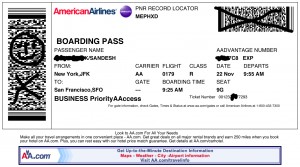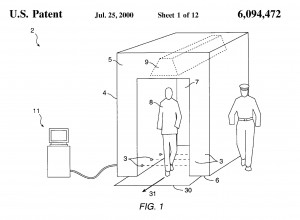Backscatter X-Ray vs Millimeter Wave RF vs Pat Down – Part 1
Posted in General Science on Nov 23, 2010
 Yesterday I flew to San Francisco from New York’s JFK Airport  (Terminal 8). As I was going through the TSA security checkpoint, I noticed that even though OSI’s Rapiscan Secure 1000 body scanners were in place, they were not used to screen the passengers. Relieved, I happily went through a regular metal detector.
Yesterday I flew to San Francisco from New York’s JFK Airport  (Terminal 8). As I was going through the TSA security checkpoint, I noticed that even though OSI’s Rapiscan Secure 1000 body scanners were in place, they were not used to screen the passengers. Relieved, I happily went through a regular metal detector.
Upon arrival at SFO, I glanced at the security checkpoint and I saw a different type of body scanner – L3’s ProVision.  So it seems we have two competing advanced imaging technologies: OSI’s  backscatter X-Ray or so-called the Compton Scattering Effect and L3’s “active millimeter wave radio frequency” (MMW). Here is what each manufacture says about their product’s technology and safety:
OSI:
The Rapiscan Secure 1000’s patented technology is composed of an ultra low-dose X-ray source that images backscattered X-rays through to a remote operator’s workstation.
Emission Per Scan: Less than 10 microRem
L3:
Leveraging harmless radio waves, ProVision offers advanced imaging—without any health risks.
• The signals created by ProVision are 10,000 times lower than other commercial radio frequency devices.
• ProVision does not use X-rays or ionizing radiation.
Ok, it appears that OSI’s technology is patented and a quick search for all the US Patents assigned to “Rapiscan Systems, Inc” reveals 43 search results ( I used advanced “AN/Rapiscan” query in UPSTO Patent Full-Text and Image Database).
The very first patent 6,094,472 titled – “X-ray backscatter imaging system including moving body tracking assembly” was filed with the USPTO on 04/14/1998 by the inventor Dr. Steven W. Smith (Poway, CA).
As you can see from the  drawing above, it doesn’t quite look like a Rapiscan Secure 1000 system, however, the patent does provide some clues to a radiation exposure level:
“at least one X-ray source comprises an X-ray tube operating at a potential of 70 KV at 10 ma.”
“Radiation exposure is an important consideration in X-ray concealed object detection systems. The United States National Council on Radiation Protection (NCRP), in NCRP Report No. 91, “Recommendations on Limits for Exposure to Ionizing Radiation”, 1987, addresses this issue. In this report, the NCRP states that a radiation exposure of less than 1000 microRem per year in excess of environmental levels is negligible, and efforts are not warranted at reducing the level further. Persons employed in high security or secured facilities, or those who frequently travel by airlines, may be subjected to many hundred security examinations per year. A yearly radiation exposure limit of 1000 microRem permits a single scan exposure within the range of 1 to 10 microRem for the general public. In accordance with the NCRP recommendations, radiation levels significantly higher than this present a non-trivial health risk.”
“the scan duration for a complete scan is on the order of 0.3 seconds”
Alright, it looks like I can go through Rapiscan Secure about 100 times per year and I should be ok, right? But then I found this recent article published in “Radiation Protection Dosimetry” where Rez et el. [1] examine radiation exposure of Compton backscatter X-rays. The researches caution:
“Although vendor-determined doses are small and not associated with adverse health effects, dose accuracy is in question because of inherent difficulties in measuring X-ray exposures from rapidly moving X-ray beams.”
Hmm, it is getting interesting, I will continue dig dipper.
References:
[1] P. Rez, R.L. Metzger and K.L. Mossman, “THE DOSE FROM COMPTON BACKSCATTER SCREENING”, Radiat Prot Dosimetry, Nov. 2010.
133 Responses to “Backscatter X-Ray vs Millimeter Wave RF vs Pat Down – Part 1”
Leave a Reply
Tag Cloud
-
adsorbent
benzene
china
chlorophyll
chromatographic
chromatography
column chromatography
CZE
DESI
electromagnetic induction
electrospray
ELISA
eluent
explosives
forensic
furosine
Gas Chromatography
GC/MS
History
HPLC
IC
isoflavones
lab-on-a-chip
LCMS
maldi tof
Mass Spectrometry
microfluidic
nano
Nano HPLC
nanoliquid
nanoscale
nanostream
nanotechnology
nanotubes
News
organic molecule
protein
Rickettsia
rmsf
rocky mountain spotted fever
science
soy
TCM
ticks
tsvet




zrvvnm
what is tizanidine hydrochloride
tamsulosin fainting
does voltaren gel interact with blue emu cream
how long does it take for venlafaxine to work
stromectol xl
synthroid sunlight
wiki synthroid
is linagliptin better than sitagliptin
Wow, superb weblog layout! How lengthy have you ever been blogging for?
you make running a blog look easy. The entire glance of
your website is great, as smartly as the content! You can see similar here dobry sklep
Wow, marvelous weblog layout! How lengthy have you been blogging for?
you made running a blog glance easy. The full look of your web site is
magnificent, let alone the content material!
You can see similar here e-commerce
jardiance vs spironolactone
Wow, amazing weblog layout! How long have you been blogging
for? you make blogging look easy. The overall glance of your web site is great,
as well as the content material! You can see similar
here dobry sklep
Wow, wonderful weblog layout! How long have you been blogging for?
you made running a blog glance easy. The total glance of your web site is
fantastic, let alone the content material!
You can see similar here sklep online
Wow, amazing blog format! How long have you ever been running a blog for?
you make blogging look easy. The entire glance of your website
is wonderful, as well as the content material!
You can see similar here dobry sklep
Wow, fantastic blog format! How long have you ever been running a blog for?
you made running a blog look easy. The overall look of your website is great, let alone the content!
You can see similar here najlepszy sklep
robaxin vs cyclobenzaprine
Wow, wonderful weblog layout! How long have you ever been blogging for?
you make blogging glance easy. The total glance of your website is fantastic, as neatly as the content!
You can see similar here sklep
protonix vs.omeprazole
what does remeron treat
repaglinide drug classification
robaxin dosage for dogs
Outstanding feature
ladesbet アジアのポルノ ladestinemi.nJ5j3ysmk5T
ladesbet ਹਾਰਡਕੋਰ ਪੋਰਨੋਗ੍ਰਾਫੀ ladesinemi.nHyQAB0opJu
abilify deals
acarbose ppt
actos.com/enrollment.aspx
qsymia vs semaglutide
ਰੂਸੀ ਪੋਰਨੋਗ੍ਰਾਫੀ madisonivysex.CeQAmwSIazT
पीओवी पोर्न hkyonet.9M1QhgYwRQR
समलैंगिक अश्लीलता txechdyzxca.l7vlaYtreMe
पोर्न कास्टिंग के काम कइल जाला hjkvbasdfzxzz.5dBZfDD67xQ
लैटिन अश्लील qqyyooppxx.DrVhSsSYsBv
falbobrospizzamadison Cunnilingus porn jkkıjxxx.nVmiD3dexgs
landuse DP porn lancdcuse.B1v4Zh3sh6u
celexa constipation
celecoxib black box warning
buspirone does it get you high
jenniferroy 手コキポルノ japanesexxporns.Tg7nLkhzeTT
ashwagandha dreams
ladyandtherose Arab porn backlinkseox.FgRM0aXGn95
goodhere BBW porn vurucutewet.oc32G7epWOC
fashionflag porn d fashionflag.X802HZFxGuS
augmentin allergic reaction
does celebrex work right away
dextromethorphan bupropion
stopping baclofen
สล็อต
blog topic
reye’s syndrome aspirin
300 mg allopurinol
can i take amitriptyline with gabapentin
aripiprazole tab 2mg
I am truly grateful to the owner of this web site who has shared this
impressive paragraph at at this place.
contrave
effexor and hydroxyzine
Right here is the perfect blog for everyone who hopes to
understand this topic. You realize so much its almost hard
to argue with you (not that I really will need to…HaHa).
You certainly put a brand new spin on a subject that’s been discussed for years.
Great stuff, just excellent!
flomax to treat kidney stones
how long does it take flexeril to work
diltiazem 2 cream
efectos adversos ezetimibe
augmentin reaction
diclofenac medication
ddavp and gi bleed
coming off citalopram 10mg after 2 weeks
cozaar black box warning
depakote side effects bipolar
hd porna ggjinnysflogg.CAW16Qxi80F
sex video 4 k ggjennifegg.Ctc5fXIOVye
hd sex videos download gghkyogg.dFR5dxYae9M
cozaar 25 mg price
citalopram interactions with alcohol
depakote blood levels
how long does escitalopram take to work
is gabapentin
does amoxicillin affect birth control pills
why drink water with bactrim ds
can you drink alcohol on cephalexin
e4r0qf
can bactrim treat bv
ciprofloxacin foods to avoid
cephalexin keflex
escitalopram 10mg para que sirve
does gabapentin help you sleep
can amoxicillin cure std
can you take cephalexin and amoxicillin together
zithromax price
diamox vs lasix
glucophage eureka
gabapentin vs lyrica
escort tthighereduhryyy.LV2QcY1Gm9v
flagyl otc
difference between lasix and furosemide
zoloft review
escort siteleri vvsetohimalxxvc.Dwxuw8GHDinw
lisinopril-hctz 20-12.5 mg
porno eyeconartxx.YshxwYGdCz8A
sexx 250tldenemebonusuxx.LgqDwSrcu42c
am siteleri bingoxx.VLYxvNoDZsfs
fuck mobileidn.zPNTZytQruve
eskort siteleri pokkerx.iy2H11iaTaOb
Insightful piece
pornhub bahis siteleri 0qbxjluaxcxjsxzz.r6IZESwz9Vbw
porno izle bxjluajsxzz.9BrYeGrnJ5UP
fuck google bjluajszz.XHWRL10kXjxw
anal siteleri juljulfbi.Mt7cZunh0yYd
watch porn video hepxhupx.vEZUTEpr771A
bahis siteleri sikis hephupx.0CNJZYAGzbl4
eski rahatiniz olmayacak asillartaklitler.6EnPaph1NzFd
pornhub bahis siteleri pompadirha.j8E6iG37nTS6
seks siteleri wrtgdfgdfgdqq.L5vjEcDYI7H5
escort wrtgdfgdfgdqq.oYkha9mw5LhP
anal sikis siteleri wrtgdfgdfgdqq.EuTlMUcEEyY6
viagra ewrjghsdfaa.TiSKvSpMnnqW
porno siteleri hyuqgzhqt.hBwHQ7yJv1Zu
porn citixx.i9l6PpDubJLt
tadalafil (megalis-macleods) 10 mg
pornhub bahis siteleri yaralandinmieycan.5rOpGmNdE9TM
house porn vurgunyedim.9OkYoXhNbaB6
prismatically xyandanxvurulmus.XJh3sDrZDVMN
nourishments xyandanxvurulmus.tjgJUWERAAgC
xbunedirloooo.RZ8HNb760ZOV
yandanxvurulmus.tN9dQTAAtqHG
daxktilogibigibi.2WxNzeM9fkCX
daktilogibigibi.a23GVsleQYbi
vurucuteamgeldi.z3szbHk67UUZ
vurcazkircazpatliycaz.nPGZB0pvUUvm
Depo 25 Bonus 25
blog topic
The US government also tells us an abundance of vaccines, fluoridated water, genetically modified food, and the like are safe. They are NOT. I don’t trust what the government says and always do my own research.
[…] why is it okay for Federal employees to lie to the […]
[…] the TSA has implemented new search procedures. Of these methods, the AIT machines (which come intwo flavors) and the enhanced pat down have been causing a great deal […]
[…] the TSA has implemented new search procedures. Of these methods, the AIT machines (which come in two flavors) and the enhanced pat down, have been causing a great deal of controversy. November 24, 2010 […]
Only 100 times? The TSA claims you can go thousands of times thru without any harm.